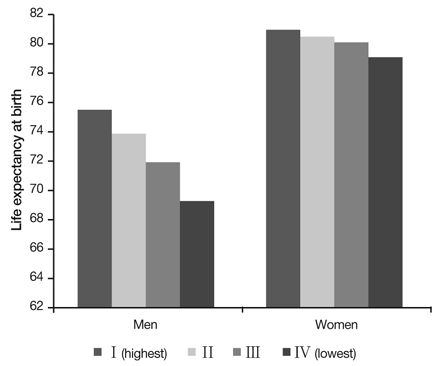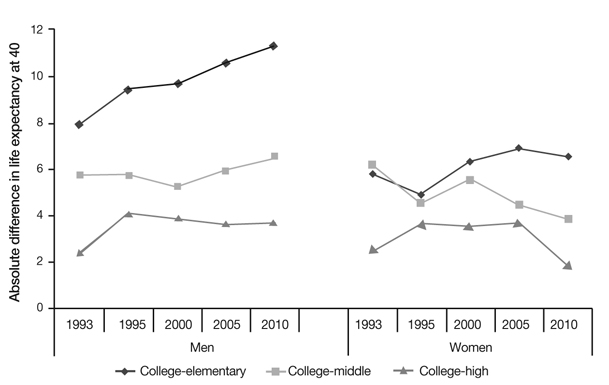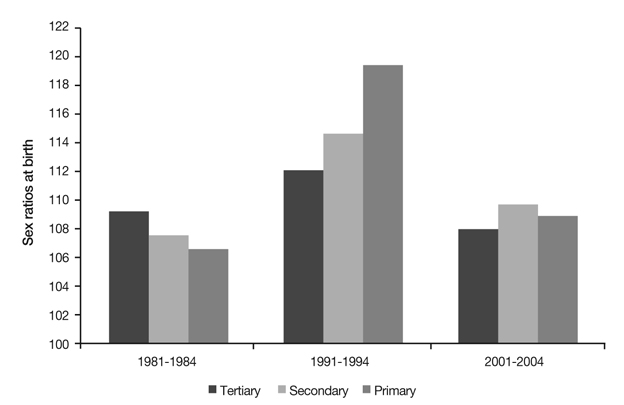J Korean Med Assoc.
2013 Mar;56(3):167-174. 10.5124/jkma.2013.56.3.167.
Socioeconomic inequalities in health status in Korea
- Affiliations
-
- 1Department of Preventive Medicine, Ewha Womans University School of Medicine, Seoul, Korea.
- 2Department of Preventive Medicine, Dona-A University College of Medicine, Pusan, Korea. kimyumi@dau.ac.kr
- KMID: 2064821
- DOI: http://doi.org/10.5124/jkma.2013.56.3.167
Abstract
- Both social interest in and studies of socioeconomic inequalities in health have increased in recent years. This article presents the current state of socioeconomic inequalities in health status in Korea, based on recent research. Socioeconomic inequalities in health status have been consistently observed in Korea as well as abroad. In both men and women, from birth-sometimes evenfrom before birth-to death, inverse relationships between socioeconomic position and most indicators of healthexist. For some health indicators, such as suicide, absolute and relative inequalities have become significantly worse than in the past. Knowledge of health inequalities in small geographic areas can be useful for allocating health resources. Representative indicators of socioeconomic inequalities in health shouldundergo ongoing monitoringby the government. In addition, there is a need for research to explore the mechanisms and to evaluate the effectiveness of specific policies and intervention programs as well as to identify socioeconomic inequalities in a variety of health outcomes. Learning the status of and trends in socioeconomic inequalities in health isan essential step toward increasing awareness of these inequalities in society and promoting an integrated and systematic policy for tackling them.
Figure
Cited by 1 articles
-
One wing of nation's health: reducing health inequalities
Young-Ho Khang
J Korean Med Assoc. 2013;56(3):165-166. doi: 10.5124/jkma.2013.56.3.165.
Reference
-
1. Kawachi I, Subramanian SV, Almeida-Filho N. A glossary for health inequalities. J Epidemiol Community Health. 2002; 56:647–652.
Article2. Macinko JA, Starfield B. Annotated bibliography on equity in health, 1980-2001. Int J Equity Health. 2002; 1:1.
Article3. Khang YH. Historical advances in health inequality research. J Prev Med Public Health. 2007; 40:422–430.
Article4. Shin YJ, Kang MG, Kim K, Kim MH, Kim MK, Kim YM, Kim IA, Yoo WS, Yoon TH, Lee S, Yim J, Jeong BG, Jung-Choi K, Cho HJ, Ju YS. 2009 Korea health inequality statistics. 2009. Seoul: Management Center for Health Promotion.5. Jung-Choi K, Kim MH, Kim YM, Sohn JI, Choi YJ. The Korean Society for Equity in Health. Health inequities in South Korea, 2009. 2011. Seoul: The Korean Society for Equity in Health.6. Khang YH. Health policy plan for tackling health inequalities in Seoul. 2012. Seoul: Seoul Metropolitan Government.7. Khang YH, Yang S, Cho HJ, Jung-Choi K, Yun SC. Decom-position of socioe-conomic differences in life expectancy at birth by age and cause of death among 4 million South Korean public servants and their dependents. Int J Epidemiol. 2010; 39:1656–1666.
Article8. Jung-Choi K, Khang YH. Contribution of different causes of death to socioeconomic mortality inequality in Korean children aged 1-9: findings from a national mortality follow-up study. J Epidemiol Community Health. 2011; 65:124–129.
Article9. Khang YH. Relationship between childhood socio-economic position and mortality risk in adult males of the Korea Labour and Income Panel Study (KLIPS). Public Health. 2006; 120:724–731.
Article10. Song YM, Smith GD, Sung J. Adult height and cause-specific mortality: a large prospective study of South Korean men. Am J Epidemiol. 2003; 158:479–485.
Article11. Jung-Choi K, Kang M, Cho SI, Khang YH, Ha EH, Chun H, Jang SN. Impact of hunger experiences in childhood or adolescence on diabetes among Korean elders. J Korean Soc Health Educ Promot. 2010; 27:81–89.12. Cho HJ, Khang YH, Yang S, Harper S, Lynch JW. Socio-economic differentials in cause-specific mortality among South Korean adolescents. Int J Epidemiol. 2007; 36:50–57.
Article13. Son M, Cho Y, Oh J, Kawachi I, Yi J, Kwon S. Social inequalities in life expectancy and mortality during the transition period of economic crisis (1993-2010) in Korea. Int J Equity Health. 2012; 11:71.
Article14. Bronnum-Hansen H, Baadsgaard M. Widening social inequality in life expectancy in Denmark: a register-based study on social composition and mortality trends for the Danish population. BMC Public Health. 2012; 12:994.
Article15. Jung-Choi K, Khang YH, Cho HJ. Changes in contribution of causes of death to socioeconomic mortality inequalities in Korean adults. J Prev Med Public Health. 2011; 44:249–259.
Article16. Lee WY, Khang YH, Noh M, Ryu JI, Son M, Hong YP. Trends in educational differentials in suicide mortality between 1993-2006 in Korea. Yonsei Med J. 2009; 50:482–492.
Article17. Cheong KS, Choi MH, Cho BM, Yoon TH, Kim CH, Kim YM, Hwang IK. Suicide rate differences by sex, age, and urbanicity, and related regional factors in Korea. J Prev Med Public Health. 2012; 45:70–77.
Article18. Woo H. Differences in healthy life expectancy by gender and education for middle-aged and older Koreans. Korean J Sociol. 2009; 43:165–187.19. Park SM, Jang SN, Kim DH. Gender differences as factors in successful ageing: a focus on socioeconomic status. J Biosoc Sci. 2010; 42:99–111.
Article20. Westley SB, Kim Choe M. How does son preference affect populations in Asia? Asia Pac Issue. 2007; 84:1–12.21. Statistics Korea. Sex ratios for provinces [Internet]. 2012. cited 2013 Jan 10. Daejeon: Statistics Korea;Available from: http://kosis.kr/abroad/abroad_01List.jsp?parentId=A.22. Chun H, Kim IH, Khang YH. Trends in sex ratio at birth according to parental social positions: results from vital statistics birth, 1981-2004 in Korea. J Prev Med Public Health. 2009; 42:143–150.
Article23. Jung-Choi K, Khang YH, Cho HJ. Socioeconomic differentials in cause-specific mortality among 14 million South Korean public servants and their dependents. J Epidemiol Community Health. 2011; 65:632–638.
Article24. Kim IH, Khang YH, Cho SI, Chun H, Muntaner C. Gender, professional and non-professional work, and the changing pattern of employment-related inequality in poor self-rated health, 1995-2006 in South Korea. J Prev Med Public Health. 2011; 44:22–31.
Article25. Kim M, Chung W, Lim S, Yoon S, Lee J, Kim E, Ko L. Socio-economic inequity in self-rated health status and contribution of health behavioral factors in Korea. J Prev Med Public Health. 2010; 43:50–61.
Article26. Kim JG. An analysis on income-related health inequality of the aged applied to EQ-5D. J Korean Gerontol Soc. 2012; 32:759–776.27. Cho AJ. Elderly abuse and what to do about it. Health Welf Policy Forum. 2008; 143:16–29.28. Kim SY, Kim MH, Kawachi I, Cho Y. Comparative epidemiology of suicide in South Korea and Japan: effects of age, gender and suicide methods. Crisis. 2011; 32:5–14.
Article29. Kim JH, Yoon TH. Comparisons of health inequalities in small areas with using the standardized mortality ratios in Korea. J Prev Med Public Health. 2008; 41:300–306.
Article30. Whitehead M. Diffusion of ideas on social inequalities in health: a European perspective. Milbank Q. 1998; 76:469–492.
Article
- Full Text Links
- Actions
-
Cited
- CITED
-
- Close
- Share
- Similar articles
-
- Relationship between Inequalities in Health and Inequalities in Socioeconomic Status
- Current status of policy developments in tackling health inequalities and the next steps to be taken in Korea
- Health Inequalities in Korea: Current Conditions and Implications
- Health Inequalities Policy in Korea: Current Status and Future Challenges
- Socioeconomic inequalities in health risk factors in Korea





